Alexei Panshin is an American writer and science fiction (SF) critic. He has written several critical works and several novels, including the 1968 Nebula Award-winning novel Rite of Passage and, with his wife Cory Panshin, the 1990 Hugo Award-winning study of science fiction The World Beyond the Hill.
Cory Panshin is an American science fiction critic and writer. She often writes in collaboration with her husband, Alexei Panshin. The Panshins won the Hugo award for Best Non-Fiction Book in 1990 for The World Beyond the Hill, a massive history of science fiction. Panshin is currently writing a "theory of human history as controlled by an evolving sequence of visions of the underlying nature of reality" which she is publishing in installments on her personal blog.

The Day of the Dinosaur is a science book by L. Sprague de Camp and Catherine Crook de Camp, illustrated with plates. It was first published in hardcover by Doubleday in 1968, and in paperback by Curtis Books in 1970 or 1971. A second hardcover edition was issued by Bonanza Books in 1985. The first chapter was reprinted as "One Day in the Cretaceous" in the de Camps's collection Footprints on Sand.

Divide and Rule is a 1948 collection of two science fiction novellas by American writer L. Sprague de Camp, first published in hardcover by Fantasy Press, and later reissued in paperback by Lancer Books in 1964. The collected pieces were previously published in 1939 and 1941 in the magazines Unknown and Astounding. The first stand-alone edition of the title story was published as a large-print hardcover by Thorndike Press in September 2003. An E-book edition of the title story was issued by Gollancz's SF Gateway imprint on September 29, 2011 as part of a general release of de Camp's works in electronic form.
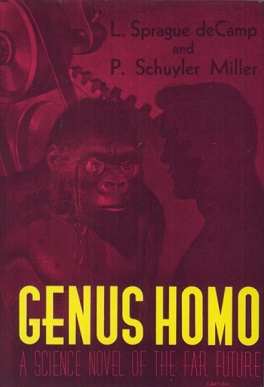
Genus Homo is a science fiction novel by American writers L. Sprague de Camp and P. Schuyler Miller. It was first published in the science fiction magazine Super Science Stories for March, 1941, and subsequently published in book form in hardcover by Fantasy Press in 1950 and in paperback by Berkley Books in 1961. An E-book edition was published by Gollancz's SF Gateway imprint on September 29, 2011 as part of a general release of de Camp's works in electronic form. It has also been translated into French, Italian and German.

Science-Fiction Handbook, subtitled The Writing of Imaginative Fiction, is a guide to writing and marketing science fiction and fantasy by L. Sprague de Camp, "one of the earliest books about modern sf." The original edition was published in hardcover by Hermitage House in 1953 as a volume in its Professional Writers Library series. A revised edition, by L. Sprague de Camp and Catherine Crook de Camp, titled Science Fiction Handbook, Revised, was published in hardcover by Owlswick Press in 1975 and as a trade paperback by McGraw-Hill in 1977. An E-book version of the revised edition was published by Gollancz's SF Gateway imprint on April 30, 2014.
Advent:Publishers is an American publishing house. It was founded by Earl Kemp and other members of the University of Chicago Science Fiction Club, including Sidney Coleman, in 1955, to publish criticism, history, and bibliography of the science fiction field, beginning with Damon Knight's In Search of Wonder.
Phoenix Pick is the science fiction and fantasy imprint of Arc Manor Publishers based in Rockville, Maryland, United States.

The World Beyond the Hill: Science Fiction and the Quest for Transcendence (1989) is a book about the history of science fiction, written by Alexei Panshin and Cory Panshin.

"Judgment Day" is an apocalyptic science fiction story by American writer L. Sprague de Camp. It was first published in the magazine Astounding Science Fiction for August, 1955, and first appeared in book form in the anthology The Best Science Fiction Stories and Novels: 1956. It later appeared in the de Camp collections A Gun for Dinosaur and Other Imaginative Tales, and The Best of L. Sprague de Camp, as well as the anthologies Great Science-Fiction, A Science Fiction Argosy, and Masters of Darkness III. The story has also been translated into German.

The Best Science Fiction of the Year #2 is an anthology of science fiction short stories edited by American writer Terry Carr, the second volume in a series of sixteen. It was first published in paperback by Ballantine Books in July 1973, and reissued in May 1976.

"Divide and Rule" is a science fiction novella by American writer L. Sprague de Camp. It was first published as a serial in the magazine Unknown from April to May, 1939 and first appeared in book form in de Camp's collection Divide and Rule. The story was revised for book publication. The first stand-alone book edition of the story was published as a large-print hardcover by Thorndike Press in September 2003. An E-book edition of the story was issued by Gollancz's SF Gateway imprint on September 29, 2011 as part of a general release of de Camp's works in electronic form.
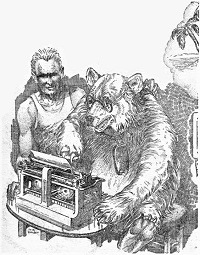
"The Command" is a science fiction story by American writer L. Sprague de Camp. An early treatment of the concept of uplift, it was the first in his Johnny Black series. It was first published in the magazine Astounding Science-Fiction for October, 1938, and first appeared in book form in the hardcover anthology Modern Masterpieces of Science Fiction. It later appeared in the paperback anthology Doorway Into Time and the subsequent de Camp collection The Best of L. Sprague de Camp. The story has also been translated into German.
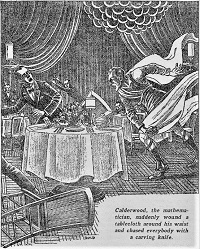
"The Isolinguals" is a science fiction story, addressing the concept of ancestral memory, by American writer L. Sprague de Camp. It was his first published story. It was first published in the magazine Astounding Stories for September, 1937, and first appeared in book form in the anthology First Flight: Maiden Voyages in Space and Time (Lancer Books, Aug. 1963; reprinted Nov. 1966 and Nov. 1969. It later appeared in the anthologies First Voyages, Tales in Time, and Wondrous Beginnings, as well as the de Camp collection Years in the Making: the Time-Travel Stories of L. Sprague de Camp.

"The Stolen Dormouse" is a science fiction novella by American writer L. Sprague de Camp. It was first published as a serial in the magazine Astounding Science-Fiction for April and May, 1941 and first appeared in book form in de Camp's collection Divide and Rule. The story has also appeared in the anthologies Astounding Stories: The 60th Anniversary Collection, and The Best of Astounding: Classic Short Novels from the Golden Age of Science Fiction.
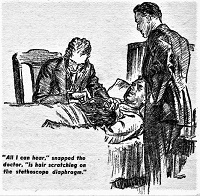
"Hyperpilosity" is a science fiction story by American writer L. Sprague de Camp. It was first published in the magazine Astounding Stories for April, 1938, and first appeared in book form in the de Camp collection The Wheels of If and Other Science Fiction (Shasta, 1949; It later appeared in the anthologies Omnibus of Science Fiction, Science Fiction of the Thirties, The Edward De Bono Science Fiction Collection, and The Road to Science Fiction #2: From Wells to Heinlein, as well as the magazine Fantastic Story Magazine and the de Camp collection The Best of L. Sprague de Camp. In 2014 the story was shortlisted for the Retro Hugo Award for Best Short Story.

"The Blue Giraffe" is a science fiction story on the concept of mutation by American writer L. Sprague de Camp. It was first published in the magazine Astounding Science-Fiction for August, 1939. It first appeared in book form in the anthology Adventures in Time and Space ; it later appeared in the anthologies World of Wonder, The Science Fiction Bestiary, Androids, Time Machines and Blue Giraffes, Isaac Asimov Presents the Great Science Fiction Stories: Volume 1, 1939, Isaac Asimov Presents The Golden Years of Science Fiction, and An Anthropomorphic Century. The story has been translated into Italian, French and German.

Lest Darkness Fall and Related Stories is an anthology of time travel alternate history stories by American writers L. Sprague de Camp, Frederik Pohl, S. M. Stirling and David Drake. It was first published in ebook trade paperback by Arc Manor under its Phoenix Pick imprint in February 2011, with a trade paperback following in March of the same year and a hardcover edition in October 2017. Arc Manor issued a second edition under its CAEZIK SF & Fantasy imprint in hardcover and ebook in February 2021, under the alternate title Lest Darkness Fall and Timeless Tales Written in Tribute; the new edition added two newly commissioned stories by David Weber and Harry Turtledove.
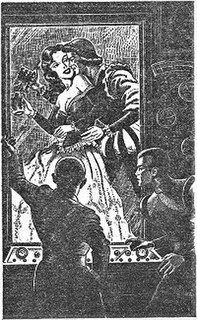
"The Saxon Pretender" is a science fiction short story by L. Sprague de Camp. It was first published under the title "Rogue Princess" in the magazine Science Fiction Quarterly for February, 1952. It first appeared in book form under the author's preferred title of "The Saxon Pretender" in the collection Sprague de Camp's New Anthology of Science Fiction.
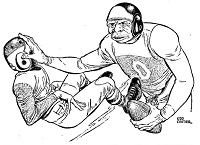
"Throwback" is a classic science fiction short story featuring atavism by L. Sprague de Camp. It was first published in the magazine Astounding Science Fiction for March, 1949. It first appeared in book form in the collection A Gun for Dinosaur and Other Imaginative Tales ; it later appeared in the anthology Apeman, Spaceman. The story has been translated into Italian and German.














